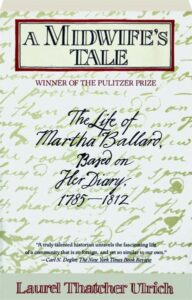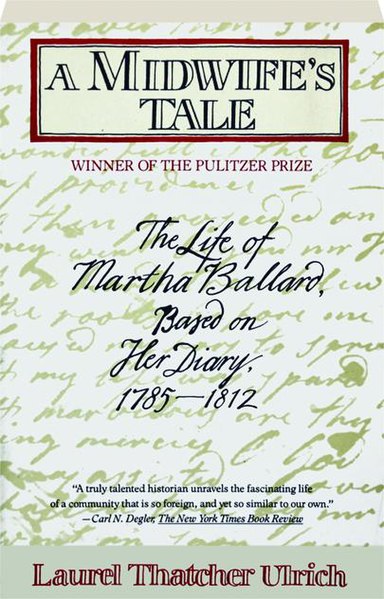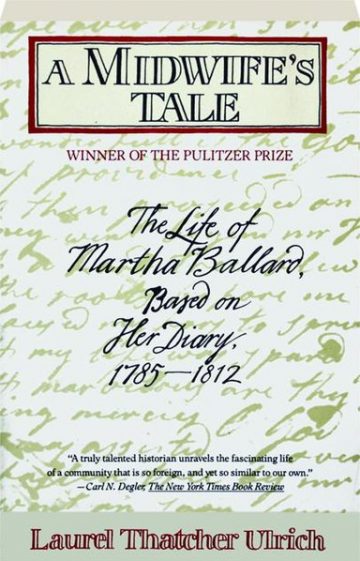 Surely no discussion of midwifery and Mormons would be complete without a nod to Laurel Thatcher Ulrich’s classic A Midwife’s Tale: The Life of Martha Ballard, Based on Her Diary 1785-1812. The dates alone should signal to you that Martha Ballard was not a member of the Church of Jesus Christ of Latter-Day Saints since the Restoration was still to come. What, then, makes this a Mormon classic? The answer is, of course, the author. Laurel Thatcher Ulrich is arguably the most prominent academic who is a member of the Church. This book won the Pulitzer Prize, making Ulrich the first member to win one. She has written many more women-centered histories including most recently A House Full of Females Plural Marriage and Women’s Rights in Early Mormonism, 1835-1870. Though I’ve never met her myself, I privately held her as my example all through graduate school that a Mormon girl could get married, have a family, and have a PhD in history and a career. She’s the historian I want to be.
Surely no discussion of midwifery and Mormons would be complete without a nod to Laurel Thatcher Ulrich’s classic A Midwife’s Tale: The Life of Martha Ballard, Based on Her Diary 1785-1812. The dates alone should signal to you that Martha Ballard was not a member of the Church of Jesus Christ of Latter-Day Saints since the Restoration was still to come. What, then, makes this a Mormon classic? The answer is, of course, the author. Laurel Thatcher Ulrich is arguably the most prominent academic who is a member of the Church. This book won the Pulitzer Prize, making Ulrich the first member to win one. She has written many more women-centered histories including most recently A House Full of Females Plural Marriage and Women’s Rights in Early Mormonism, 1835-1870. Though I’ve never met her myself, I privately held her as my example all through graduate school that a Mormon girl could get married, have a family, and have a PhD in history and a career. She’s the historian I want to be.
A Midwife’s Tale is based on the diaries of a woman living in the early days of the United States. Martha Ballard began her diary when she was fifty and kept it until shortly before she died. Ulrich puts excerpts from the diary at the beginning of each chapter, making the source come alive and feel close to the reader. Very few records exist from midwives in any period of American history, so this source gives us a vital glimpse into many stages of womanhood. There are records of births both in and out of wedlock, babies who thrive and babies who perish, and mothers who bear many children and mothers who die. Her care for women was not limited to births either – she helped with breastfeeding and mastitis and other difficulties specific to women. In order to tend her neighbors she walked across frozen rivers, left home day or night in adverse conditions and frequently had to canoe across the Kennebec river to reach her patients.
However, the diary illuminates far more than stories of pregnancy and parturition. The intimate contact she had with women also made her responsible to testify about what she knew of them. One chapter details a high-profile rape case in which Mrs. Foster accused Judge North of assaulting her while her husband was gone. Mrs. Foster having confided in Ballard multiple times, the latter had to give testimony to what she knew, and fortunately for us she also wrote her testimony down in her diary. Another colonial-era practice was to question women in labor about the paternity of their children, if it were in doubt. The judicial assumption seemed to be that a woman being tortured by labor pains, and facing her own mortality, would not lie. Thus Ballard questioned unwed mothers and recorded her findings: “Shee was safe delivered at 1 hour pm of a fine son, her illness very severe but I left her cleverly & returnd… about sun sett. Sally declard that my son Jonathan was the father of her child.” (147) She also filled a role today we would assign to a coroner. She was present to witness a boy’s death, then the following day “I was Calld to my sons to see the Desection fo the Son of Esquire Davis which was performd very Closly.” She carefully details her observations of the dead boy’s innards, and also notes that she, along with other women, “put on the Grave Cloaths.” (236). In this case she had been present to see the boy into the world, and was there to usher him to the other side as well.
Ulrich does a wonderful job of creating a narrative and making the sometimes cryptic and sparse entries come to life with contextual details that orient the reader to a territory that seems very foreign to 2020. It is, however, dense reading and can be challenging for a casual reader. Fortunately for folk who become overwhelmed reading the book, PBS created a documentary that dramatizes the diary for viewers while also following Ulrich on her process of discovering and exploring the original source material. It is called “A Midwife’s Tale: Eighteenth-Century America Through A Woman’s Eyes” and the DVD is available through Netflix and Amazon. It’s possible there’s an online version to stream, but a cursory search hasn’t yielded much success for me.
Whether you choose the book or the film, it is well worth your time to get to know Martha Ballard and Laurel Thatcher Ulrich better.






7 Responses
Em,
Thanks for the book review. I started but did not finish the book. I will go back to it.
Ulrich must have spent years researching not only the journals but the geography and history of Maine.
It’s amazing what this one woman (Ballard) did for her community, what Ulrich has done for ours and what historians like you continue to do each day.
Em, your posts are always thoughtful and factual. Looking forward to your book!
Thanks for this terrific review! I watched the PBS documentary years ago, and it has stuck with me. What an incredible painstaking process to contextualize the sparse entries and weave it all together so skillfully.
I didn’t even know there was a film!
Thank you so much for this review! I was never quite fully interested in midwifery, so knew of this book, but had passed on it, However, your words “The intimate contact she had with women also made her responsible to testify about what she knew of them”– sold me. There is so much more to this book than what I had mistakenly presumed. Thank you so much for this review– this book is now on my must-read list.
i really enjoyed this book
Thanks, friends. It is perhaps a bit dense for a beach read, but it is truly delightful when you have the mental space to give to it.
I love this review. As a Exponent II founding mother, Laurel Thatcher Ulrich holds a special place in our history. Great work, Em!
I met Laurel Thatcher Ulrich at a book signing. I was absolutely thrilled to meet her as not only a great admirer of her work, but with the kinship of sisterhood and also being from Idaho. I remember telling her how frequently I think of Martha Ballard. I did not imagine the impact the book would have on my life.